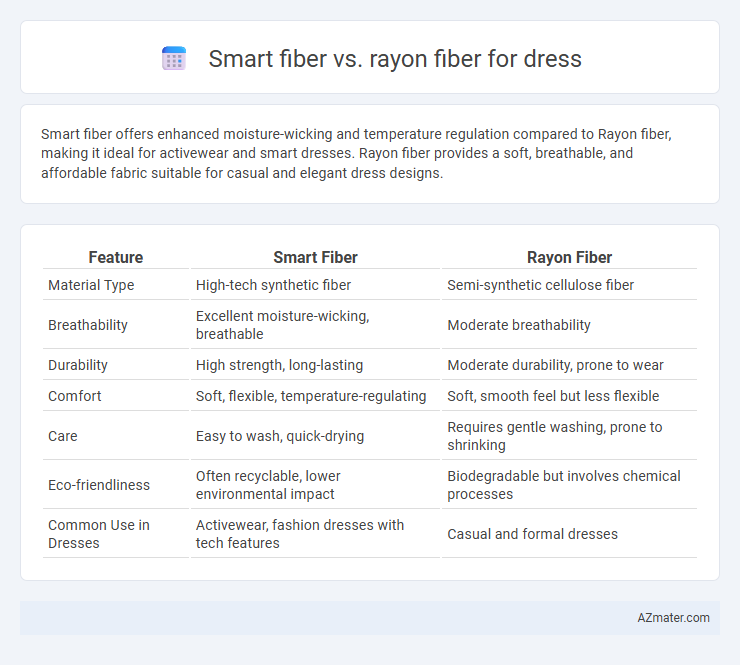Smart fiber offers enhanced moisture-wicking and temperature regulation compared to Rayon fiber, making it ideal for activewear and smart dresses. Rayon fiber provides a soft, breathable, and affordable fabric suitable for casual and elegant dress designs.
Table of Comparison
| Feature | Smart Fiber | Rayon Fiber |
|---|---|---|
| Material Type | High-tech synthetic fiber | Semi-synthetic cellulose fiber |
| Breathability | Excellent moisture-wicking, breathable | Moderate breathability |
| Durability | High strength, long-lasting | Moderate durability, prone to wear |
| Comfort | Soft, flexible, temperature-regulating | Soft, smooth feel but less flexible |
| Care | Easy to wash, quick-drying | Requires gentle washing, prone to shrinking |
| Eco-friendliness | Often recyclable, lower environmental impact | Biodegradable but involves chemical processes |
| Common Use in Dresses | Activewear, fashion dresses with tech features | Casual and formal dresses |
Introduction to Smart Fiber and Rayon Fiber
Smart fiber, engineered with advanced technology, offers enhanced moisture-wicking, breathability, and durability, making it ideal for performance-focused dresses. Rayon fiber, a semi-synthetic material derived from cellulose, provides a soft, smooth texture with excellent drape and comfort suited for casual and formal wear. Comparing Smart fiber and Rayon fiber highlights the balance between innovative fabric performance and traditional fabric aesthetics in dressmaking.
Defining Smart Fiber: Features and Composition
Smart fibers, designed with advanced materials such as conductive polymers and shape-memory alloys, offer dynamic responses to environmental stimuli like temperature and moisture, enhancing comfort and functionality in dresses. Unlike rayon fiber, which is a semi-synthetic cellulose fiber derived from wood pulp known for its softness and breathability but limited in adaptive properties, smart fibers integrate technology to regulate thermal conditions and control moisture. The composition of smart fibers involves intelligent molecular structures that provide durability and enhanced performance, making them ideal for high-tech fashion applications.
What Is Rayon Fiber? Origin and Properties
Rayon fiber is a semi-synthetic textile made from regenerated cellulose, primarily derived from wood pulp, cotton linters, or bamboo. Originating in the late 19th century as an early alternative to silk, rayon is prized for its smooth texture, excellent drape, breathability, and moisture absorption, making it ideal for dress materials. Its versatility allows for various finishes that can mimic natural fibers like cotton, wool, or silk while remaining biodegradable and comfortable to wear.
Comparing Comfort: Smart Fiber vs. Rayon
Smart fiber offers superior breathability and moisture-wicking properties compared to rayon, enhancing comfort by keeping the wearer dry and cool throughout the day. Rayon, while soft and smooth against the skin, tends to retain moisture and may feel heavier or damp in humid conditions. The advanced technology in smart fibers makes them more effective in regulating body temperature and providing a consistently comfortable wearing experience.
Durability and Longevity in Dress Fabrics
Smart fiber offers superior durability and longevity compared to rayon fiber in dress fabrics due to its advanced molecular structure designed for enhanced strength and resistance to wear and tear. Rayon fiber, while soft and breathable, tends to weaken quickly with repeated washing and exposure to moisture, resulting in shorter fabric lifespan. Choosing smart fiber for dresses ensures prolonged fabric integrity, maintaining shape and appearance over extended use.
Breathability and Moisture Management
Smart fiber in dresses offers superior breathability compared to rayon fiber, allowing better air circulation and keeping the wearer cooler in warm conditions. Rayon fiber tends to retain moisture longer, whereas smart fibers are engineered with advanced moisture-wicking properties that efficiently draw sweat away from the skin. These features make smart fiber an ideal choice for activewear and dresses requiring enhanced comfort through effective moisture management.
Eco-Friendliness and Sustainability
Smart fiber, often derived from recycled or biodegradable materials, offers superior eco-friendliness compared to traditional Rayon fiber, which is chemically intensive and less sustainable due to its wood pulp origin processed with harmful solvents. Smart fiber's production minimizes water usage, reduces carbon footprint, and supports circular fashion initiatives, positioning it as a more sustainable choice for dress fabrics. Rayon fiber's environmental impact includes deforestation and pollution, making smart fiber a preferable option for eco-conscious apparel manufacturers.
Fashion Versatility and Aesthetic Appeal
Smart fiber offers exceptional fashion versatility due to its durability, wrinkle resistance, and ease of dyeing, making it ideal for vibrant, long-lasting dresses in various styles. Rayon fiber provides a soft, silky texture with excellent drape, enhancing the aesthetic appeal of dresses through its smooth finish and ability to mimic natural fibers like silk or cotton. Combining smart fiber's functional benefits with rayon's luxurious look allows designers to create fashionable dresses that balance practicality and elegance.
Cost Comparison: Smart Fiber vs. Rayon Dresses
Smart fiber dresses typically have a higher upfront cost compared to rayon fiber dresses due to advanced manufacturing technologies and enhanced durability. Rayon dresses offer a more budget-friendly option with a lower price point but may require more frequent replacement due to lower durability. Cost-efficiency depends on balancing initial investment with long-term wear and maintenance of the fabric.
Choosing the Right Fiber for Modern Dresses
Smart fibers offer advanced moisture-wicking and temperature-regulating properties, making them ideal for modern dresses designed for active lifestyles and comfort. Rayon fibers provide a smooth, breathable texture with excellent drape, enhancing the elegance and flow of contemporary dresses. Choosing the right fiber depends on prioritizing performance features in smart fibers or the luxurious feel and versatility of rayon for varied dress styles.

Infographic: Smart fiber vs Rayon fiber for Dress
 azmater.com
azmater.com